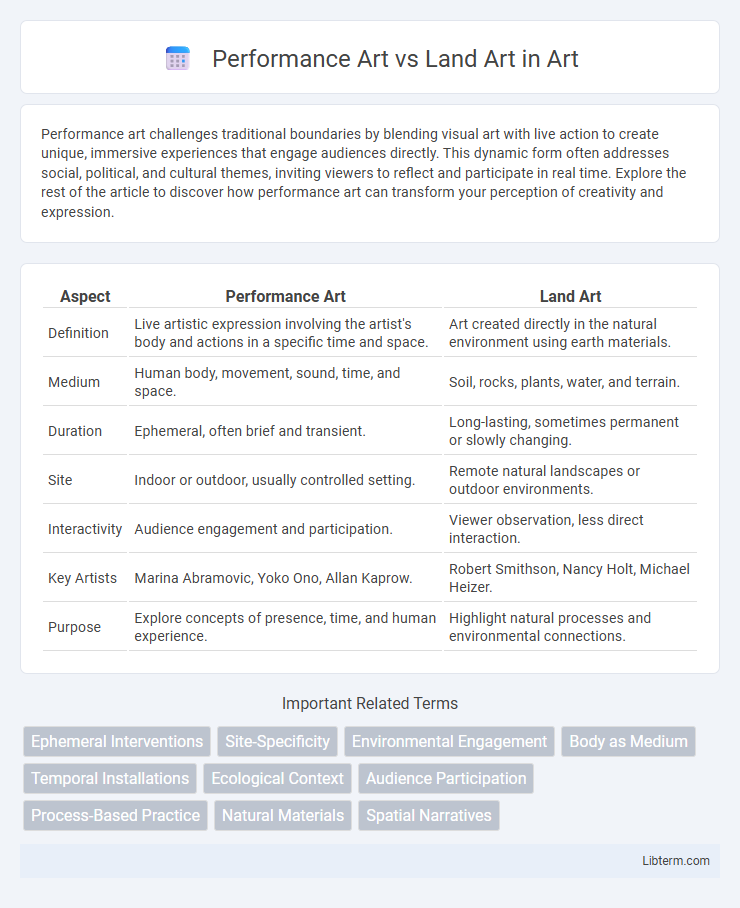Performance art challenges traditional boundaries by blending visual art with live action to create unique, immersive experiences that engage audiences directly. This dynamic form often addresses social, political, and cultural themes, inviting viewers to reflect and participate in real time. Explore the rest of the article to discover how performance art can transform your perception of creativity and expression.
Table of Comparison
| Aspect | Performance Art | Land Art |
|---|---|---|
| Definition | Live artistic expression involving the artist's body and actions in a specific time and space. | Art created directly in the natural environment using earth materials. |
| Medium | Human body, movement, sound, time, and space. | Soil, rocks, plants, water, and terrain. |
| Duration | Ephemeral, often brief and transient. | Long-lasting, sometimes permanent or slowly changing. |
| Site | Indoor or outdoor, usually controlled setting. | Remote natural landscapes or outdoor environments. |
| Interactivity | Audience engagement and participation. | Viewer observation, less direct interaction. |
| Key Artists | Marina Abramovic, Yoko Ono, Allan Kaprow. | Robert Smithson, Nancy Holt, Michael Heizer. |
| Purpose | Explore concepts of presence, time, and human experience. | Highlight natural processes and environmental connections. |
Introduction to Performance Art and Land Art
Performance Art emphasizes live, time-based actions where the artist's body and presence create a direct interaction with the audience, often challenging traditional art forms and spaces. Land Art, emerging in the late 1960s, transforms natural landscapes into site-specific installations that highlight environmental processes and human impact on nature. Both genres expand artistic boundaries by integrating experience, environment, and temporality, yet Performance Art centers on ephemeral enactment while Land Art focuses on physical alteration of terrain.
Historical Origins and Development
Performance Art originated in the early 20th century as artists like Marcel Duchamp challenged traditional art forms by incorporating time-based, live actions into their work, evolving through movements such as Futurism and Dadaism. Land Art emerged in the late 1960s, pioneered by artists like Robert Smithson and Nancy Holt, who utilized natural landscapes as both medium and canvas to explore environmental themes and challenge gallery constraints. Both forms disrupted conventional art settings, with Performance Art emphasizing temporal experience and Land Art highlighting site-specific, environmental interaction.
Defining Characteristics of Performance Art
Performance Art emphasizes live presentation, where the artist's body, actions, and presence are central to conveying meaning. It often incorporates elements of theater, dance, and visual art, focusing on temporality, audience interaction, and spontaneous expression. Unlike Land Art, which engages with natural landscapes over time, Performance Art is defined by its ephemeral, process-based nature and direct human involvement.
Key Features of Land Art
Land Art transforms natural landscapes using materials like soil, rocks, and vegetation to create large-scale, site-specific installations. Its key features include permanence or intentional ephemerality, integration with the environment, and emphasis on the changing natural conditions such as weather and erosion. Unlike Performance Art, Land Art is primarily visual and spatial, often located in remote outdoor settings, challenging traditional gallery contexts.
Influential Artists in Performance and Land Art
Influential performance artists like Marina Abramovic and Yoko Ono transformed the art world by using their bodies and actions as mediums, emphasizing temporality and audience interaction. In contrast, land art pioneers such as Robert Smithson and Nancy Holt reshaped natural landscapes into monumental, site-specific installations that challenge traditional gallery spaces. Both movements redefined artistic boundaries, with performance art prioritizing ephemeral human presence and land art focusing on enduring environmental interventions.
Artistic Intentions and Audience Engagement
Performance Art centers on ephemeral actions where artists use their bodies and presence to challenge norms, provoke emotions, and create an immediate connection with the audience. Land Art emphasizes transforming natural landscapes to explore humanity's relationship with the environment, encouraging viewers to engage contemplatively with nature. Both art forms prioritize immersive experiences but differ in temporal focus and interaction, with Performance Art being transient and interactive, while Land Art offers lasting alterations to a physical site.
The Role of Space and Environment
Performance art transforms space into a dynamic stage, interacting directly with the audience and emphasizing temporality and human presence within urban or gallery settings. Land art integrates natural landscapes as both medium and subject, altering terrain to highlight environmental processes and engage with ecology over extended timeframes. The role of space in performance art centers on ephemeral experience and social interaction, while land art prioritizes physical integration and lasting environmental impact.
Materials and Techniques Used
Performance Art primarily utilizes the human body as both medium and material, emphasizing ephemeral actions, gestures, and interactions often documented through video or photography. Land Art engages directly with natural landscapes, employing earth, rocks, soil, and organic materials, using techniques like excavation, stacking, and site-specific installations to alter or highlight the environment. The contrast lies in Performance Art's transient, time-based nature versus Land Art's physical, durable modifications to natural surroundings.
Preservation and Documentation Challenges
Performance Art faces significant preservation challenges due to its ephemeral nature, relying heavily on video recordings, photographs, and artist testimonies to document its transient moments. Land Art, created in remote natural environments, confronts difficulties in maintaining the artwork against environmental degradation, erosion, and human interference, complicating efforts to preserve the original intentions. Documentation for Land Art often includes site maps, GPS coordinates, and detailed photographic archives to ensure future study and understanding despite its impermanence.
Impact and Legacy in Contemporary Art
Performance Art revolutionized contemporary art by emphasizing the artist's presence and ephemeral experiences, influencing multimedia and interactive art forms. Land Art reshaped environmental consciousness within art through large-scale outdoor installations, fostering ecological awareness and site-specific creativity. Both movements significantly impact contemporary practices by expanding artistic boundaries and challenging traditional gallery contexts.
Performance Art Infographic

 libterm.com
libterm.com